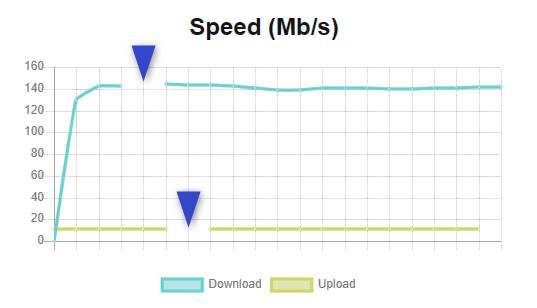How to troubleshoot your internet connection
Updated
Shadow PC is a cloud-based streaming service that transmits high amounts of data. A stable, reliable internet connection is important.
Users often identify problems with their local internet connection when they report experiences of stuttering, freezing, lagging, pixelation, or blurriness. If you're experiencing any of these issues, this article may help you to achieve a smooth, stable, and responsive performance.
Read this article to see the best practices for Shadow PC and learn how to troubleshoot your internet connection.
Checklist for troubleshooting internet issues
Before diving in, make sure you're following the best practices to boost your streaming experience. The suggestions below can help Shadow PC perform optimally. Use Shadow's tools to identify network issues.
Check the minimum internet requirements
Shadow PC relies on five key metrics to ensure a stable connection:
Download Speed: A minimum of 15 Mb/s is required for smooth streaming.
Upload Speed: At least 5 Mb/s is sufficient, but higher speeds (up to 100 Mb/s) are better for devices like webcams or controllers.
Ping: Aim for 30 ms or less to minimize lag. Issues often occur above 35 ms.
Jitter: Should be minimal to avoid stuttering or interruptions.
Packet Loss: Any level of packet loss will lead to repercussions.
Use Shadow's Easy Speedtest to check these metrics. If issues persist, try switching between a wired and wireless connection or restart your network equipment.
Check your local network equipment and devices
Turn off VPNs and whitelist Shadow PC in your antivirus. Some antiviruses also have an option to temporarily disable them.
Try to connect with another device. To use Shadow, devices should conform to our device requirements.
Try another network. If your symptoms improve or disappear, the issue may be coming from your local network.
Follow Shadow's best practices to improve latency
You can minimize latency with the right settings and adjustments. Check out our best practices to learn how.
Tools for troubleshooting your internet
You can try running an Easy Speedtest to test your internet connection's speed and stability. Alternatively, the Usage Stats panel can be used to see what is causing latency.
Easy Speedtest
The Easy Speedtest evaluates the internet connection from your local device to your Shadow PC's data center, measuring download speed, upload speed, ping, and jitter over time. The results will be displayed as a graph.
To run the Easy Speedtest:
Close Shadow PC.
Choose your data center from the list of locations below.
The Easy Speedtest will open in your browser. Click Run Speedtest.
After running the Easy Speedtest, review the graph and compare your results to the minimum internet requirements.
📝 Your data center is displayed on the Shadow PC launcher. Open the launcher, click the Help icon, and scroll to the bottom. If you don’t have an active subscription, choose the data center closest to you.
Location | Data Center |
FRDUN02 | |
DEFRA01 | |
FRSBG01 | |
USWDC01 | |
USPOR01 | |
CAMTL01 |
💡 Gaps in the graph, like the ones displayed in the example below, can be a sign of packet loss. You can also see packet loss in the Usage Stats.

Usage stats
Shadow has a dashboard for monitoring your connection called the Usage Stats, located in the Quick Menu. Your Usage Stats panel has information about the quality of the internet connection between:
Your local device (1) to your internet box (2) (e.g., modem or router).
Your internet box and the data center hosting Shadow PC (3).
By monitoring these metrics in the Usage Stats dashboard, you can pinpoint where latency occurs and take targeted steps to improve your connection.
.png)
If there's high latency between:
Your local device and internet box
Check your local network equipment and devices. Latency here indicates that it's taking a long time for your device to communicate with your network.
Pause downloads and streaming. Stop any downloads or streams running in the background on your device to free up bandwidth.
Restart your router/modem. Unplug it from the power socket, wait 30 seconds, then plug it back in and restart.
Check the cables. Ensure all cables are securely connected and functioning properly.
Reset your router/modem: If restarting doesn’t help, reset it to factory settings using your ISP’s instructions.
Contact your ISP. If the issue persists, check with your ISP for potential service problems.
Your internet box and Shadow PC
Check the minimum internet requirements. Latency from your internet box to Shadow indicates an issue outside your local network.
See our status page. Please verify that there is no ongoing incident in your data center by looking at our status page.
Review your firewall settings. Make sure that your firewall settings do not block Shadow or the ports necessary for its operation. See how to make your firewall compatible with Shadow.
Make sure Shadow PC is up to date. Check that your version of Shadow PC is up to date and download any available updates from your launcher.
When to contact Support
If the instructions in this article did not help improve your connection to Shadow PC, provide your troubleshooting results, including screenshots of the Easy Speedtest, to Shadow Support.
Still have questions after reading this article?
Check out our other articles or contact Shadow Support.

